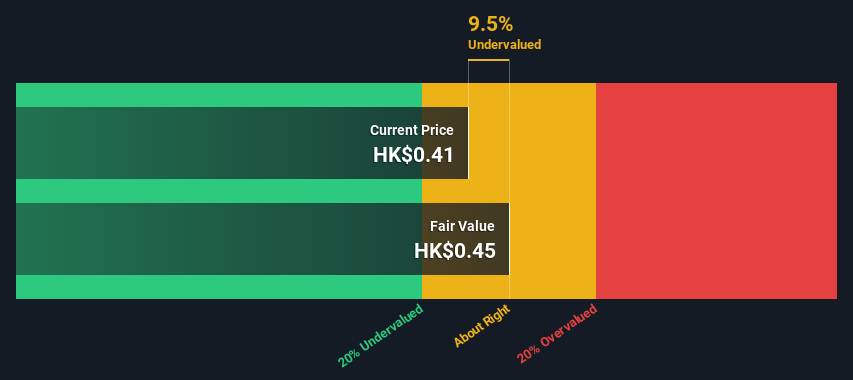- Hong Kong
- /
- Retail Distributors
- /
- SEHK:8395
Calculating The Fair Value Of ZXZN Qi-House Holdings Limited (HKG:8395)

Key Insights
- ZXZN Qi-House Holdings' estimated fair value is HK$0.45 based on 2 Stage Free Cash Flow to Equity
- Current share price of HK$0.41 suggests ZXZN Qi-House Holdings is potentially trading close to its fair value
- The average premium for ZXZN Qi-House Holdings' competitorsis currently 13%
Does the December share price for ZXZN Qi-House Holdings Limited (HKG:8395) reflect what it's really worth? Today, we will estimate the stock's intrinsic value by taking the forecast future cash flows of the company and discounting them back to today's value. We will take advantage of the Discounted Cash Flow (DCF) model for this purpose. Believe it or not, it's not too difficult to follow, as you'll see from our example!
We generally believe that a company's value is the present value of all of the cash it will generate in the future. However, a DCF is just one valuation metric among many, and it is not without flaws. Anyone interested in learning a bit more about intrinsic value should have a read of the Simply Wall St analysis model.
Check out our latest analysis for ZXZN Qi-House Holdings
What's The Estimated Valuation?
We use what is known as a 2-stage model, which simply means we have two different periods of growth rates for the company's cash flows. Generally the first stage is higher growth, and the second stage is a lower growth phase. In the first stage we need to estimate the cash flows to the business over the next ten years. Seeing as no analyst estimates of free cash flow are available to us, we have extrapolate the previous free cash flow (FCF) from the company's last reported value. We assume companies with shrinking free cash flow will slow their rate of shrinkage, and that companies with growing free cash flow will see their growth rate slow, over this period. We do this to reflect that growth tends to slow more in the early years than it does in later years.
A DCF is all about the idea that a dollar in the future is less valuable than a dollar today, and so the sum of these future cash flows is then discounted to today's value:
10-year free cash flow (FCF) estimate
| 2025 | 2026 | 2027 | 2028 | 2029 | 2030 | 2031 | 2032 | 2033 | 2034 | |
| Levered FCF (HK$, Millions) | HK$16.6m | HK$21.0m | HK$25.1m | HK$28.6m | HK$31.6m | HK$34.2m | HK$36.4m | HK$38.3m | HK$40.0m | HK$41.4m |
| Growth Rate Estimate Source | Est @ 36.81% | Est @ 26.47% | Est @ 19.23% | Est @ 14.16% | Est @ 10.62% | Est @ 8.13% | Est @ 6.40% | Est @ 5.18% | Est @ 4.33% | Est @ 3.73% |
| Present Value (HK$, Millions) Discounted @ 6.7% | HK$15.6 | HK$18.4 | HK$20.6 | HK$22.0 | HK$22.8 | HK$23.1 | HK$23.0 | HK$22.7 | HK$22.2 | HK$21.6 |
("Est" = FCF growth rate estimated by Simply Wall St)
Present Value of 10-year Cash Flow (PVCF) = HK$212m
After calculating the present value of future cash flows in the initial 10-year period, we need to calculate the Terminal Value, which accounts for all future cash flows beyond the first stage. The Gordon Growth formula is used to calculate Terminal Value at a future annual growth rate equal to the 5-year average of the 10-year government bond yield of 2.3%. We discount the terminal cash flows to today's value at a cost of equity of 6.7%.
Terminal Value (TV)= FCF2034 × (1 + g) ÷ (r – g) = HK$41m× (1 + 2.3%) ÷ (6.7%– 2.3%) = HK$962m
Present Value of Terminal Value (PVTV)= TV / (1 + r)10= HK$962m÷ ( 1 + 6.7%)10= HK$501m
The total value is the sum of cash flows for the next ten years plus the discounted terminal value, which results in the Total Equity Value, which in this case is HK$713m. The last step is to then divide the equity value by the number of shares outstanding. Compared to the current share price of HK$0.4, the company appears about fair value at a 9.5% discount to where the stock price trades currently. The assumptions in any calculation have a big impact on the valuation, so it is better to view this as a rough estimate, not precise down to the last cent.

Important Assumptions
Now the most important inputs to a discounted cash flow are the discount rate, and of course, the actual cash flows. If you don't agree with these result, have a go at the calculation yourself and play with the assumptions. The DCF also does not consider the possible cyclicality of an industry, or a company's future capital requirements, so it does not give a full picture of a company's potential performance. Given that we are looking at ZXZN Qi-House Holdings as potential shareholders, the cost of equity is used as the discount rate, rather than the cost of capital (or weighted average cost of capital, WACC) which accounts for debt. In this calculation we've used 6.7%, which is based on a levered beta of 0.909. Beta is a measure of a stock's volatility, compared to the market as a whole. We get our beta from the industry average beta of globally comparable companies, with an imposed limit between 0.8 and 2.0, which is a reasonable range for a stable business.
Next Steps:
Valuation is only one side of the coin in terms of building your investment thesis, and it shouldn't be the only metric you look at when researching a company. DCF models are not the be-all and end-all of investment valuation. Preferably you'd apply different cases and assumptions and see how they would impact the company's valuation. For instance, if the terminal value growth rate is adjusted slightly, it can dramatically alter the overall result. For ZXZN Qi-House Holdings, we've compiled three pertinent factors you should further examine:
- Risks: As an example, we've found 2 warning signs for ZXZN Qi-House Holdings (1 is potentially serious!) that you need to consider before investing here.
- Other High Quality Alternatives: Do you like a good all-rounder? Explore our interactive list of high quality stocks to get an idea of what else is out there you may be missing!
- Other Top Analyst Picks: Interested to see what the analysts are thinking? Take a look at our interactive list of analysts' top stock picks to find out what they feel might have an attractive future outlook!
PS. Simply Wall St updates its DCF calculation for every Hong Kong stock every day, so if you want to find the intrinsic value of any other stock just search here.
Valuation is complex, but we're here to simplify it.
Discover if ZXZN Qi-House Holdings might be undervalued or overvalued with our detailed analysis, featuring fair value estimates, potential risks, dividends, insider trades, and its financial condition.
Access Free AnalysisHave feedback on this article? Concerned about the content? Get in touch with us directly. Alternatively, email editorial-team (at) simplywallst.com.
This article by Simply Wall St is general in nature. We provide commentary based on historical data and analyst forecasts only using an unbiased methodology and our articles are not intended to be financial advice. It does not constitute a recommendation to buy or sell any stock, and does not take account of your objectives, or your financial situation. We aim to bring you long-term focused analysis driven by fundamental data. Note that our analysis may not factor in the latest price-sensitive company announcements or qualitative material. Simply Wall St has no position in any stocks mentioned.
About SEHK:8395
ZXZN Qi-House Holdings
Engages in the sale, distribution, and rental of furniture and home accessories in the People’s Republic of China.
Excellent balance sheet and slightly overvalued.
Market Insights
Community Narratives




